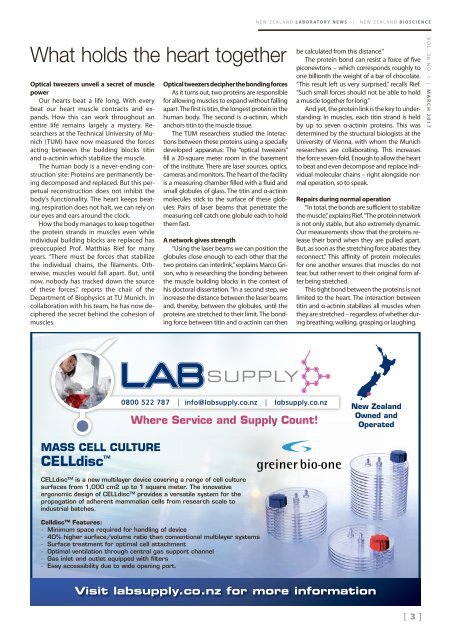Laboratory news & BioScience March 2017
New Zealand's leading scientific publication for more than 20 years. This bi-monthly magazine provides the latest up to date information on new products and services to a readership which is carefully targeted and updated on a regular basis.
New Zealand's leading scientific publication for more than 20 years. This bi-monthly magazine provides the latest up to date information on new products and services to a readership which is carefully targeted and updated on a regular basis.
You also want an ePaper? Increase the reach of your titles
YUMPU automatically turns print PDFs into web optimized ePapers that Google loves.
NEW ZEALAND LABORATORY NEWS | NEW ZEALAND BIOSCIENCE<br />
What holds the heart together<br />
Optical tweezers unveil a secret of muscle<br />
power<br />
Our hearts beat a life long. With every<br />
beat our heart muscle contracts and expands.<br />
How this can work throughout an<br />
entire life remains largely a mystery. Researchers<br />
at the Technical University of Munich<br />
(TUM) have now measured the forces<br />
acting between the building blocks titin<br />
and α-actinin which stabilize the muscle.<br />
The human body is a never-ending construction<br />
site: Proteins are permanently being<br />
decomposed and replaced. But this perpetual<br />
reconstruction does not inhibit the<br />
body’s functionality. The heart keeps beating,<br />
respiration does not halt, we can rely on<br />
our eyes and ears around the clock.<br />
How the body manages to keep together<br />
the protein strands in muscles even while<br />
individual building blocks are replaced has<br />
preoccupied Prof. Matthias Rief for many<br />
years. “There must be forces that stabilize<br />
the individual chains, the filaments. Otherwise,<br />
muscles would fall apart. But, until<br />
now, nobody has tracked down the source<br />
of these forces,” reports the chair of the<br />
Department of Biophysics at TU Munich. In<br />
collaboration with his team, he has now deciphered<br />
the secret behind the cohesion of<br />
muscles.<br />
Optical tweezers decipher the bonding forces<br />
As it turns out, two proteins are responsible<br />
for allowing muscles to expand without falling<br />
apart. The first is titin, the longest protein in the<br />
human body. The second is α-actinin, which<br />
anchors titin to the muscle tissue.<br />
The TUM researchers studied the interactions<br />
between these proteins using a specially<br />
developed apparatus: The “optical tweezers”<br />
fill a 20-square meter room in the basement<br />
of the institute. There are laser sources, optics,<br />
cameras and monitors. The heart of the facility<br />
is a measuring chamber filled with a fluid and<br />
small globules of glass. The titin and α-actinin<br />
molecules stick to the surface of these globules.<br />
Pairs of laser beams that penetrate the<br />
measuring cell catch one globule each to hold<br />
them fast.<br />
A network gives strength<br />
“Using the laser beams we can position the<br />
globules close enough to each other that the<br />
two proteins can interlink,” explains Marco Grison,<br />
who is researching the bonding between<br />
the muscle building blocks in the context of<br />
his doctoral dissertation. “In a second step, we<br />
increase the distance between the laser beams<br />
and, thereby, between the globules, until the<br />
proteins are stretched to their limit. The bonding<br />
force between titin and α-actinin can then<br />
be calculated from this distance.”<br />
The protein bond can resist a force of five<br />
piconewtons – which corresponds roughly to<br />
one billionth the weight of a bar of chocolate.<br />
“This result left us very surprised,” recalls Rief.<br />
“Such small forces should not be able to hold<br />
a muscle together for long.”<br />
And yet, the protein link is the key to understanding:<br />
In muscles, each titin strand is held<br />
by up to seven α-actinin proteins. This was<br />
determined by the structural biologists at the<br />
University of Vienna, with whom the Munich<br />
researchers are collaborating. This increases<br />
the force seven-fold. Enough to allow the heart<br />
to beat and even decompose and replace individual<br />
molecular chains – right alongside normal<br />
operation, so to speak.<br />
Repairs during normal operation<br />
“In total, the bonds are sufficient to stabilize<br />
the muscle,” explains Rief. “The protein network<br />
is not only stable, but also extremely dynamic.<br />
Our measurements show that the proteins release<br />
their bond when they are pulled apart.<br />
But, as soon as the stretching force abates they<br />
reconnect.” This affinity of protein molecules<br />
for one another ensures that muscles do not<br />
tear, but rather revert to their original form after<br />
being stretched.<br />
This tight bond between the proteins is not<br />
limited to the heart. The interaction between<br />
titin and α-actinin stabilizes all muscles when<br />
they are stretched – regardless of whether during<br />
breathing, walking, grasping or laughing.<br />
VOL. 26 NO. 1 | MARCH <strong>2017</strong><br />
0800 522 787 | info@labsupply.co.nz | labsupply.co.nz<br />
[ 3 ]


















